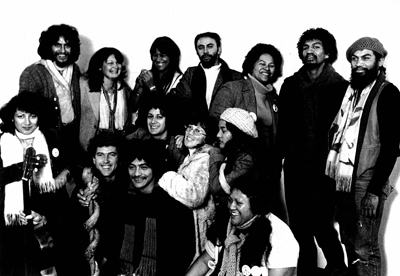Let’s pass through the flack cloud of the moment: Hone Harawira and white mofos! We’ll take ‘white mofo’ first. Don’t get too upset about the terminology. I agree that it’s inappropriate language for an MP, but it’s street talk and isn’t necessarily on about issues of race. For instance, as a member of the Black Power I regularly get called ‘Nigga!” by the members of the Mongrel Mob. It’s true, it happens all the time! It’s a patently ridiculous assertion if it’s meant to suggest that I come from Negroid stock. But it doesn’t – in the moment it just means that they don’t like me because I’m a member of another group. If Hone calls me a ‘white mofo’ I’m not too fussed either. I’m comfortable in my skin as a card-carrying Pakeha, a member of Tangata Tiriti, and a paid up subscriber to the Treaty of Waitangi. I’m a Kiwi, belong here, and am subject to conservation and protection orders. Apart from the intimations of what might well become the meltdown of the first really significant emergence of a discreet Maori body politic you might permit a wry smile about the feigned shock and rhetoric of outrage from his political opponents. Last night on the Comedy Channel there was a “Roast” (wherein supposed friends take the piss out of each other) for some insignificant star. Anyway, a white comedian called the other white comedians ‘white mutha fuckers’ and everyone in the audience howled with mirth. Apparently mofo is a hilarious assertion in North America. Hone has long been a practitioner of political comedy, but spouting ‘white mofos’ in a moment of angry response is simply an adolescent ejaculation, a spontaneous and careless stain on the sheets of his career. His style is to respond to challenge with aggressive defiance. It has generally served him well. But, in this case there was a nemesis, a virtual pen pal, an email mate, a buddy called Buddy. With buddies like that who the hell needs enemies?
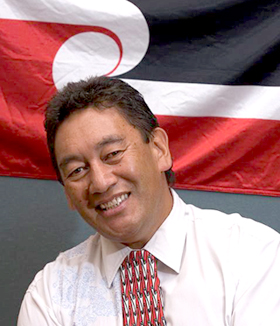
Hone Harawira. Source: Maoriparty.org
I’ve known Hone for well over thirty years – since the foundation of Nga Tamatoa I suppose. The relationship has been ambiguous – in private conversation he is courteous to me and the dialogue is intelligent and considered. In public though, he takes the piss out of me at every opportunity. In which ever way he has me framed it just doesn’t seem able to move on. Generally he takes cheap shots. I handle them without taking offence and getting destructive because, generally, the kaupapa we are engaged in is bigger than either of us. I don’t mind taking a bit of stick if it helps balance out the thrashing given to the tangata whenua by my kith and kin over the last 170 years of settler occupation. When Hone calls us ‘rapists’, and if rape means taking something by force, he’s dead right. That’s we make those apologies in our Treaty Settlements. Like many others I’ve sometimes been burned by Hone’s arrogance and cursed his self-defeating behaviours. For my sins, at one time, as the Manager of Marketing & Communications for the Department of Internal Affairs, I ended up organising the Waitangi Day celebrations at Waitangi. There was always the intergenerational ‘Harawira factor’ to contend with. At one stage, prior to a major and potentillay ‘breakthrough’ Waitangi Day event I believed I had established a good and trusting working relationship with Hone. We had worked honestly and openly together for three or four months, planning a commemoration that promised to enable respect to be paid to both Tangata Whenua and Tangata Tiriti. Our shibboleth was Ruatara’s response to the Treaty ‘Takoto te Pai’ (It is a good thing that rests there).

However it all flew to bits when the pressure came on and ended up with Dame Kath being spat at and Hone throwing a left hook at Wira Gardiner during the haururu. I mused to myself at the time that I had experienced gang leaders exercising more commitment to an agreement than Hone had shown in this instance. Yet I’ve no compunction about supporting the guy. As a nation we need him. When he gets over his self-absorbed shit he will prove to be a leader of national significance. It might not necessarily be in Parliament though. However it would be tragic to lose him. On a good day he is superb, on a bad day you get what we got. Matt Rata demonstrated to the North that a lone voice is a bit of a waste of time, so I hope he hangs in there, and accepts the authority of his caucus and leadership. What are his other options? Winston Peters has accused Hone of being like a gang member. Well Hone did attend the now contentious meeting convened by Pita Sharples and Maori gang leaders. At that meeting Hone said he’d resign from Parliament if he ever felt he couldn’t make a difference. He could take Winston’s petard and shove it back up him. What would happen if he stepped into the Maori gang leadership void to lead the Maori gangs beyond our own self defeating behaviours and Gonville lifestyles. What would happen if he used his skills and leadership to promote radical change at the very edge of society? He could form a contemporary and militant Nga Tamatoa Hou. He could expand the Maori political paradigm beyond the Maori middle class. He could complement the political discipline and even-handedness being shown by Tariana and Pita with a bit of good old Nga Puhi radicalism. He could scare the shit out of whitey at the same time as cleaning up the act of the brown proletariat. He could be the Maori Saul Alinsky. The little voice says. “Go Dougy. Get de perm”. I hope not and I hope the tent of the Maori Party stays erect through this little squall.
He died with his mind engaged and his boots on, did Martyn Sanderson. Martyn was a Renaissance man, and, beyond that, an intellectual. Accordingly, a question could result in a long answer: a deep realisation, in a ceaseless quest. As a young Antipodean scholar, in that curious warp and wove of experience that constitutes life, and links people and places across the passage of time, Martyn was taught at Oxford, about the magic of language, by none other than JR Tolkein. It must have seemed surreal when Peter Jackson selected Aotearoa as the virtual site of Middlearth for his film of the ‘Lord of the Rings’ trilogy, and chose Martyn to play one of Tolkein’s characters. These existential loops, theatrical ‘deus ex machina’, seem to be a feature of his work and efforts. After completing his period of study Martyn Sanderson embarked on a life of reflective action. He was always acutely aware of political context and social structure. He understood the power of theatre to speak the truth about both. Martyn Sanderson was a (some say ‘the’) driving force in the establishment of Downstage Theatre in Wellington, and thus a pioneer of ‘professional’ theatre in New Zealand. He undertook a thousand projects and fought a hundred thousand battles across cause and continent. Whichever the project, or the action of the day, you could be sure they would feature consistent themes of human rights, global justice, racial equality, and respect for, and celebration of, cultural difference. Martyn Sanderson was part of Bruno Lawrence’s Electronic Travelling Apparition (Blerta). Although I’d been on the periphery of the Blerta experience having hooked up with them in Timaru when their bus broke down near my dad’s service station I don’t recall any close relationship with Martyn in the Blerta context. The people I most related to were Bruno Lawrence and Corben Simpson. To my recall my first real and personal engagement with Martyn was in 1979, with the ‘Keskidee Aroha’ project, and his co-production with Merita Mita of a movie of the Keskidee tour. It’s the thirtieth anniversary of the Keskidee Tour of New Zealand. I’ve written little shards about it before (check out blog “Reggae’s Doing Fine” – February 2009). Keskidee was an Afro-Caribbean Arts Centre off the Caledonian Road, in Gifford St., Islington, London. I visited it in 1977. Keskidee was run by a diminutive guy called Oscar Abrahams who, like Martyn Sanderson, was driven by a desire to raise political and cultural consciousness through the medium of theatre.

Martyn Sanderson. Photo by: Winton Cleal – The Dominion Post
Oscar used to say that a community discovering itself in this way creates its own future. It was the haunt of the likes of Linton Kwesi Johnson and in fact, many of the luminaries of London’s “Black” arts scene – including Bob Marley. Bob was at Keskidee filming the “Is this Love” video when the leaders of the two big gangs in Kingston, Jamaica, came to convince him to go back to Jamaica – he’d been living in London in self imposed exile after the hit on him – for the famous “One Love” concert. When I visited in 1977 racial tensions were high. The Keskidee was adjacent to a block of ‘council’ flats housing predominantly white families. I think it was trashed by the National Front at one stage. It served as a virtual youth centre for the local Black Youth. Oscar was great with them – he reckoned they’d respond to anything they could call their own. The same is true here in Aotearoa, and it is the challenge of every community organisor to get balance between the ownership of the youth and accountability to the funder. In any case, in 1977, damn, Keskidee was surely theirs. I can remember being really intimidated when these clusters of Rude Bwoy gathered around me on my first visit there, letting me know that in my mofo whiteness I was not welcome. At Martyn’s funeral service – or it may have been at the aftermatch – the story was told how, when he was visiting tribal members in Africa, a guy seized him by the throat, demanding his name, prepared to kill him if he was related to the white mofo British soldier families that had killed the man’s people. Martyn’s view was that you’ve just got to ride it through with an honest heart and open mind. Have no fear. Another weave: it was to the Keskidee Centre that we sent Tigi Ness when it came to the last stages of the preparation of the Keskidee Tour – and thus to a great degree the place and Ras Messengers served as the catalyst for a Rastafarian dynasty in Aotearoa. And now the warp: Hone Harawira too was one of the Keskidee collective. In fact just before the tour commenced he led the He Taua attack on the engineering students (white mofos for sure) at Auckland University because of their cultural disrespect for the haka. It’s an interesting footnote to the current rumpus that recently the engineering students invited the members of He Taua back to the campus to apologise for their former ignorance, and to demonstrate how far along the road to appreciation of Maori culture they had now come. I remember at the same time how racially charged things were even within the Keskidee Aroha collective. On the eve of the initial tour schedule there was an organisational coup. In many ways us ‘whiteys’ were cut out of the organisation. My Maori wife Taape was allowed to attend meetings but I wasn’t. It was binary, black or white. At that time part of the network were a group called Maranga Mai. One of their songs went …
Hey Maori people, Stand up, stand up for your rights, Don’t let the white man oppress you, Come on, come on, come on.
By the time of the last workshop of the Tour the song had grown another degree of consciousness. A new inclusive verse had been added.
Hey Pakeha people, Don’t let the white man oppress you.
Maranga Mai 1979
‘White man’, ‘white mofo’, really refers to a state of mind, or sets of behaviours rather than skin colour or race. These days we might include property investment company directors amongst their midst. Anyway in 1979 I think there would be broad agreement that the worst white mofo in Aotearoa was my mentor, Rob Muldoon. In an ironic gesture, a stitch out of sequence in the tapestry of the times, intended, I am sure, to confuse future historians, I managed to convince Rob Muldoon, as Prime Minister of New Zealand, to visit the Keskidee Centre. It reportedly had the Home Office gobsmacked. It would have been like Margaret Thatcher visiting the Wellington Black Power. Another weave: Keskidee gave us the fiery Kenyan actress Wanjiku wu Kairie. Wanjiku toured New Zealand as part of the Keskidee cast, and who, in leading us back to the other central figure of this narrative, eventually ended up as Martyn Sanderson’s soul mate and partner.

Muldoon at Keskidee, Oscar on far left, Wanjiku on Muldoon's left, Jane Kominik, New Zealand High Commission on far right
When I talk of Martyn dying with his “boots on” I mean the man was at it to the end. With his team in ‘Africa Connection’, even as the angel of death stalked nearby, Martyn was fulfilling a long held dream in staging the powerful African play, “Muntu”, and continuing his established philosophy of enabling cultural exchange between Aotearoa and Africa. In itself Muntu has intricate links of its own with Wanjiku, herself a former star of the play in a former life. For this production Martyn secured the services of the Kenyan actor, playwrite, director and commentator on African art, Waynoke Njuguna and teamed him up with local Wellington performing arts students and members of the African community.
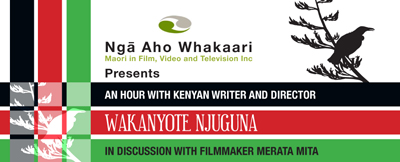
Staging Muntu had meant undertaking the long and arduous task of finding the bucks, never easy, and particularly so in a recession. Then there were the logistics, the pragmatics of getting the show on the road. It was not easy, but, narrow as, the old fulla brought it all together successfully. In these latter months he looked like shit. He was hospitalised for a time. You could hardly hear the man’s voice above his gasps for elusive oxygen. Yet, he made it happen. Martyn Sanderson was an unyielding ‘Oxford man’. Focus. Resilience. Boatrace. Blue. Two days before the Otaki performance, having completed the programme for the show, Martyn shooed Wanjiku, and the cast, off to rehearsal. Then he snuffed it. The kumara vine spread the word. By the time I had travelled down to Otaki to pay my respects, he was back at home, laid in state, clad in his final costume, rather conservative garb as he liked to dress, proudly displaying his gong, a medal and ribbon I hasten to add. Meanwhile the show went on. Muntu was performed in Otaki, the Hutt, and in Wellington. The last performance was staged the day before his burial, bravely with Wanjiku as a member of the cast. Martyn and Wanjiku, exemplary troupers. Martyn Sanderson was inscrutable at the best of times, but it seemed to me, as I stood at the foot of his coffin, that, even against the rules of rigour mortis, at the realisation of this final endeavour, he gave me a subtle smile of contentment. The plaudits at his funeral were some measure of the breadth of his success: besides the family, brothers and sisters, children and grandchildren, we heard from Geoff Murphy and Ian Mune, along with other pou of the New Zealand film and theatre sector. Waynoke gave a moving tribute and led the African mourners, who filled perhaps a third of the church, in a farewell lament. Waiata, haka, African chant. World music. World dance. World consciousness. Perhaps the most profound testimony of all however was from the tangata whenua. Ngati Toa brought the Pakeha Martyn Sanderson into the bosom of their land for eternity by making the magnificent church Rangiatea available for his service, and by inviting his whanau to lay him at rest in the ancestral Urupa, on a hillock behind the whare karakia. Rangiatea relates to the birthplace of Polynesian, much in the same way as Africa is recognised as the cradle of human civilisation: more weave in the whariki of Martyn’s life. After the funeral we gathered for a few drinks, a movie retrospective of Martyn’s work, and those little speeches of endearment, memory, and love.
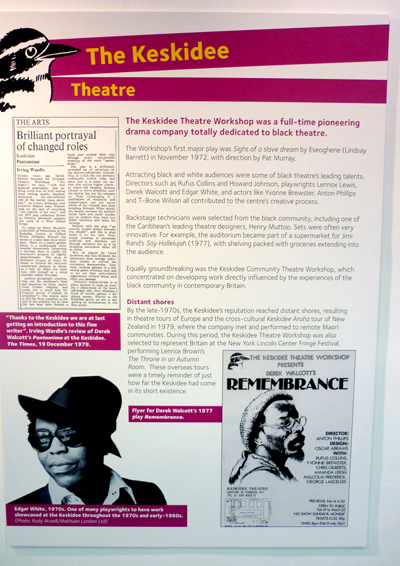
Keskidee Retrospective
Back in London there is a retrospective ‘Keskidee Exhibition’ being staged, reflecting on its impact on the contemporary black history of the area. It features the Keskidee tour of New Zealand. Dr Robbie Shilliam of Victoria University is currently researching the Keskidee story and tracing its various impacts both here in Aotearoa and back in England. I look forward to seeing his work. On Guy Fawke’s Day, hosted by Nga Aho Whakaari (the collective of Maori in Film and TV) Waynoke teamed up with Merita Mita to give hold a workshop in Auckland called “The Place of the Cultural Practitioner in a Post Colony”. The ghost of Martyn at work nei! He kehua pai. Job well done e te tuakana, te rangatira. Haere, haere atu ra.
Last month I hooked up with Emory Douglas, the Black Panthers’ Minister of Culture, in Auckland, and he showed me through his exhibition of Panther Art, strong social comment: using art to express anger and frustration and to create social change. It laid the platform for a Black President. It is powerful stuff, incendiary to a degree that makes Hone sound very mild indeed. You may have heard about the knight-Mayor recently promoting eugenics and suggesting that the poor and benefit dependent be offered money to be sterilised and thus produce no seed. Similar line, different party, Hone’s fellow Ngapuhi MP, Shane Jones was quoted in the NZ Herald as saying that the Maori Party should stop referring to gang members as ‘our people’. “They’re not our people” he said, “in fact they’re not even people. They’re slaves. In pre-Christian times they would have been despatched”. That has to be as strong an assertion as white mofo, but as it accords with the majority viewpoint it earned a tick not attack. Somewhat earlier in the year I read Jimmy Baxter at the Auckland Library as part of the National Poetry Day. Included in my repertoire was ‘The Maori Jesus’. People came up to me later. “When you read that you made me cry”. No, it was the power of the poet, the power of the theatre. We urgently need to revive theatre at a community level, at least to overcome the fright of being called white mofos and spinning into moral panic about reverse racism. Beyond that we need to rediscover ways to let us deal with our emotions and feelings on one plane, without corroding or destroying the ability on another plane to work with and alongside each other when it comes to building the nation.
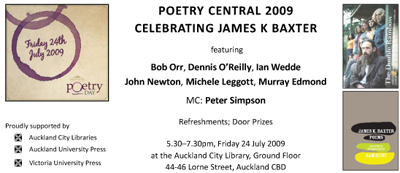
Hey, in all this whiteness korero what about the All Whites getting into the World Cup. Good on you all. It’s interesting that both Falloon and Wynton Rufer have whakapapa Maori. Wynton reckons that the future for NZ Soccer rests in getting young Maori and other Polynesian involved in the sport. Those fast twitch genes and physicality hold promise. On the other hand that match against Bahrain was the first time in ages that I’ve only heard the one verse of the National Anthem being sung – the verse in Maori was missing. It’s carrying the ‘white out’ thing a bit far don’t you think? Get it right bros.
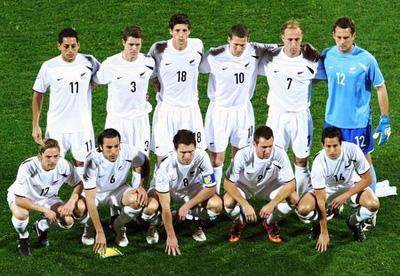
The All Whites. Source: Oceaniafootball.com
It’s been one hell of a year. I’ve been flat out, and it shows. The issue of methamphetamine use has risen above the distracting chatter and has now been taken in hand by the Prime Minister. Last week I spent three days at a hui with Mike Williams Chief Executive of the Stellar Trust, and I am heartened by the way in which he is approaching the challenge ahead. Next week I am going to attend the graduation of the first intake of families into the Mongrel Mob Notorious’ P addiction recovery programme. Last Saturday I talked to the Salvation Army staff who are facilitating the programme and they were full of praise about the demonstrably positive shifts amongst the participating families. This is change on the very edge of New Zealand society. There is hope abroad and I am encouraged to work even harder. I’ll try and pull the threads together in a final blog for the year next month. Warp and weave, and lets put things white. Until then, Arohanui. D






